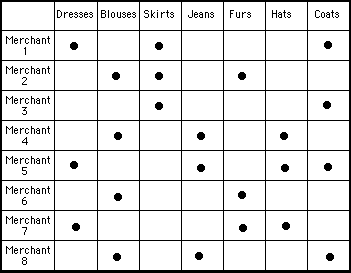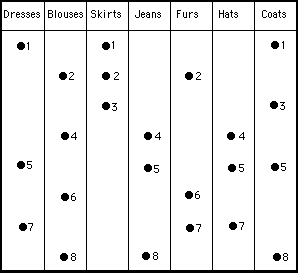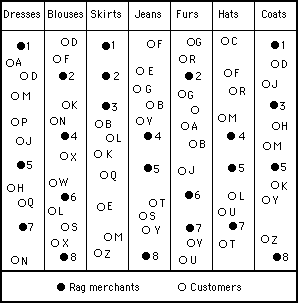

Formatting a people space
A conventional database algorithm will use parameters that specify various relevant information about a product. A simple two parameter description might appear as a two dimensional table as shown in figure 5, where merchants are listed against the items of clothes they supply.
 alt="diagram"
alt="diagram"
Figure 5 - Using rows and columns a two dimensional table is created. Each dot in the space represents a merchant (identified by the name in the row) who supplies a particular type of garment (specified by the description of the column)
The trick now is to imagine each dot in this space as representing a merchant. Conceptually, the diagram then stops being a table and becomes a number of boxes that contain merchants. For example, the part of the space reserved for blouses (the blouses column) becomes a box that contains every merchant who supplies blouses. If somebody wants blouses, they can be imagined as visiting the box allocated to blouses (the blouse column) where they will find all the merchants in the country who are supplying them.
This situation is illustrated in figure 6, where the merchants are identified with a reference number (eliminating the need to have them represented as rows in a table).

Figure 6 - Each category of garment can be thought of as a box that contains several merchants. Any merchant (each identified by a reference number) can be in several boxes at the same time
In the same way that merchant can be represented as dots in a garment space, so can buyers. Figure 7 shows a mixture of merchants and buyers visiting the spaces allocated to types of garment that are being supplied or bought. Merchants are identified with numbers and buyers are identified with letters. Using these identifications to obtain the necessary contact details, merchants and buyers can visit appropriate boxes to communicate with each other directly.
Conceptually, it is as if the people in each of these garment spaces (boxes) were together in a virtual cafe, where they'd each be free to wander around and talk to each other. Thus, instead of seeing a tabular representation, you have a picture in mind of a number of cafes – each attracting a uniquely different group of people who have a particular niche interest.

Figure 7 - Buyers can be thought of as visiting the spaces to find merchants who supply the garments they want. Merchants can be thought of as visiting the spaces to find buyers for the garments they are supplying. Each garment space can be thought of as a virtual cafe where those present can talk to each other
From figure 7, it is easy to see how there wouldn't be any need for algorithms or management to organise any information exchange – if only merchants and buyers could physically be in these spaces to talk to one another. However, by using bots to represent them, they could have virtual presence in these spaces and, through their bots, be able to interact and communicate with each other.
If these bots were also allowed to add extra columns, to specify additional garments that are being supplied or are wanted, the whole database could be run by the users themselves through their bots. Then, there wouldn't be any need for building or maintenance from the server side. In fact, the server side needn't even have any direct contact with the users at all – because through a self-organisation process the people, through their bots, would be able to make all the appropriate contacts themselves.
Would such a system work? There is a very good precedence. Napster, the peer to peer networking phenomenon that threatened to bring down the entire music publishing industry worked on a similar principle. During the dotcom bubble, while other startups were obtaining millions of dollars in funding and failing spectacularly to create viable information systems, Napster, with virtually no capital and little organisation, attracted 12 million people who used Napster's very simple peer to peer networking system to exchange music with each other. Napster did very little more than provide a way for people of similar interests to get in contact with each other directly - and they didn't even use bots or format the people space.